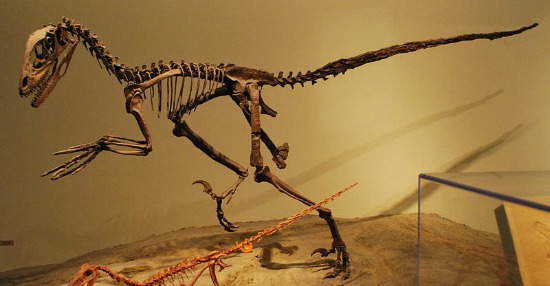Tracking Raptors
At an Early Cretaceous site in China, paleontologists have discovered a rich trove of raptor tracks
![]()

A reconstruction of Deinonychus showing how this dinosaur walked on two-toed feet. Photo by AStrangerintheAlps, image from Wikipedia.
When I think of theropod tracks, the mental image that immediately pops up is of three-toed depressions with conspicuous indentations where the dinosaur’s claws dug into the substrate. After all, theropod means “beast foot,” and many theropod tracks seem to fit the name. But not all theropod dinosaurs balanced on three toes. The deinonychosaurs–the group of sickle-clawed dinosaurs that included the more slender troodontids and the bulky hypercarnivorous dromaeosaurids–ambled through the Mesozoic on two toes, with their curved switchblade claw held off the ground. Over the past two decades, paleontologists have found these two-toed tracks at multiple sites around the world. Most, however, have been found in China, and researchers have just issued a profile of one of the richest deinonychosaur tracksites anywhere.
The in-press Acta Palaeontologica Polonica study, written by Lida Xing and colleagues, describes an Early Cretaceous tracksite at the Liujiaxia Dinosaur National Geopark in Gansu Province, China. The site preserves 71 deinonychosaur tracks. These footprints are unique enough that the paleontologists gave them a new name–Dromaeosauripus yongjingensis. It may seem strange to name tracks, especially since we don’t know exactly what species of dinosaur made them, but trace fossil experts name particular types of tracks to keep track of the different kinds of animals that left the impressions. If a track type is unique and consistent from print to print, then it often gets its own moniker.
Of course, tracks record fossil behavior. At the new site, at least two trackways show that individual dinosaurs turned while walking. Unlike other sites, though, there isn’t any evidence for social raptors here. Based upon the spacing of the tracks and other details, the paleontologists Xing and co-authors hypothesize that the deinonychosaur trackways were made by individual animals that walked along the same surface at different times.
But what kind of deinonychosaur made the tracks? This is the Cinderella Syndrome–fitting the right trace to the proper tracemaker. Unless a dinosaur literally dies in its tracks, paleontologists can only outline the general kind of dinosaur who left the footprints. In this case, the choice is between a troodontid and a dromaeosaurid.
Footprint size isn’t especially helpful. Most troodontids were relatively small, while dromaeosaurids could grow to 20 feet long or more. The footprints at the site were made by dinosaurs ranging from two to 10 feet long, and this means that the larger animals were close to the known upper limit for troodontid size. Frustratingly, size alone is too ambiguous to distinguish between a troodontid or dromaeosaurid trackmaker.
To narrow down the possibilities, Xing and collaborators turned to another clue. The toe lengths of troodontids and dromaeosaurids are slightly different. While the fourth (or outermost) toe of troodontids is slightly shorter than the neighboring third toe, the two supporting toes in dromaeosaurids are typically just about equal in length. The tracks at the site more closely match the dromaeosaurid pattern. Thanks to this tracksite, we can imagine feathery dinosaurs akin to Deinonychus strutting across Cretaceous China.
Reference:
Xing, L., Li, D., Harris, J.D., Bell, P.R., Azuma, Y., Fujita, M., Lee, Y.-N., and Currie, P.J. (2012). A new Dromaeosauripus (Dinosauria: Theropoda) ichnospecies from the Lower Cretaceous Hekou Group, Gansu Province, China Acta Palaeontologica Polonica DOI: 10.4202/app.2011.0115
/https://tf-cmsv2-smithsonianmag-media.s3.amazonaws.com/accounts/headshot/RileyBlack.png)
/https://tf-cmsv2-smithsonianmag-media.s3.amazonaws.com/accounts/headshot/RileyBlack.png)